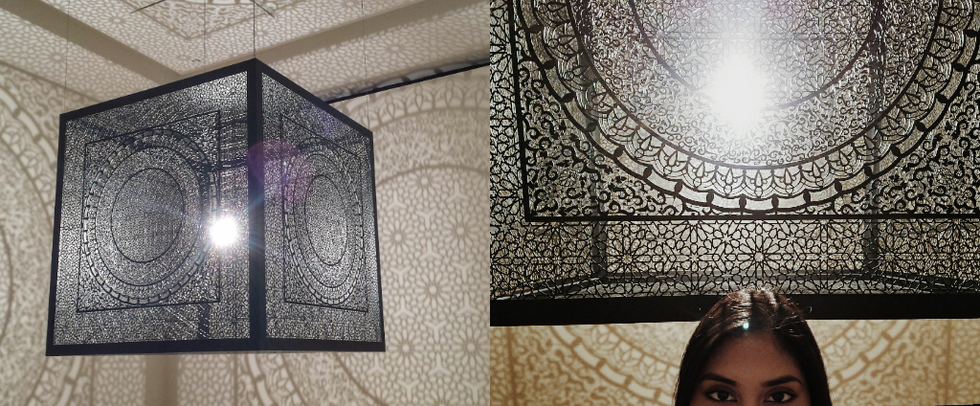It’s strange to see myself reflected in the darkness of the charcoal portrait. Chitra Ganesh’s "Devika Rani (2012)," depicts a woman far too regal to encounter me. The subject features an elaborate headpiece, a bindi above her brows, and eyes that are hauntingly beautiful. Dressed in jeans and having just taken a final, my reflection mars her work. It is, however, an incredible feeling to find art I see myself represented in; there aren't many museums where I can find a portrait of a woman adorned with a bindi.
The Asia Society Museum, from June 27th to August 6th, 2017, features "Lucid Dreams and Distant Visions: South Asian Art in the Diaspora." Only a four-minute walk from the 68th Street stop on the 6 train, the Asia Society Museum exclusively displays traditional and contemporary Asian art. The current exhibit includes nineteen contemporary artists from the South Asian diaspora, all of whom now live in the United States, and possess work spanning four decades. Collectively, the group depicts the South Asian experience: socially, culturally, and with regards to the tensions in the international sociopolitical climate.
Though the exhibit only occupies the second floor of a relatively small museum, it is unassumingly powerful. I was emotionally overwhelmed once finished with it; its impact is difficult to put into words.
Anila Quayyum Agha's "Crossing Boundaries," is arguably the most 'Instagrammable' feature of the exhibit, but the laser-cut steel and light bulb installation reflects the contradictory qualities inherent in the immigrant experience. The geometric patterns of the installation are meant to mimic those of traditional mosques in Pakistan. Being a woman, Agha was excluded from these while growing up in Pakistan. The space that her art creates, however, is open to people of all creed, color, and belief.
There are incredibly diverse portrayals of the South Asian community: portraits of overlooked silent-film actors, paintings of Muslims in various fields of work, critiques of appropriated South Asian culture in Western Society, and short films about Tibetan refugees. While some artists provide very direct imagery of the social and cultural makeup of their homelands, others are more layered in their depiction of cross-cultural tensions and racial boundaries.
The impact of a place on a person's work is resonant throughout the exhibit. Ruby Chishti's "The Present is a Ruin Without the People," pictured below, represents the spaces that individuals have unwillingly left in times of conflict and war. Chishti attempts to demonstrate the relationship that forms between the personal experiences that immigrants encounter, and the singular narratives that are applied to them as a group.The numerous textiles she uses, like so many of the artworks displayed, prompt questions over the endless, and varied stories hidden in them.
Overwhelmingly, the exhibit combats the xenophobia and nationalism that flood our nation. The artists widen the narrative surrounding immigrants and attempt to rid viewers of their existing stereotypes, providing detailed individual stories and trials. They reveal how little anyone, (and even I, a child of South Asian descent), knows about history; people of color have been so severely overlooked.
Coincidentally, the exhibit meets with the seventieth anniversary of Indian independence from British rule. The art displayed celebrates the genuine expression of South Asian lives, in all of their duality.
For immigrants, the children of them, and anyone of South Asian descent, this exhibit is no less than a love letter to you. It ends on August 6th, 2017. Don't miss an opportunity to see your heritage take the spotlight.



















